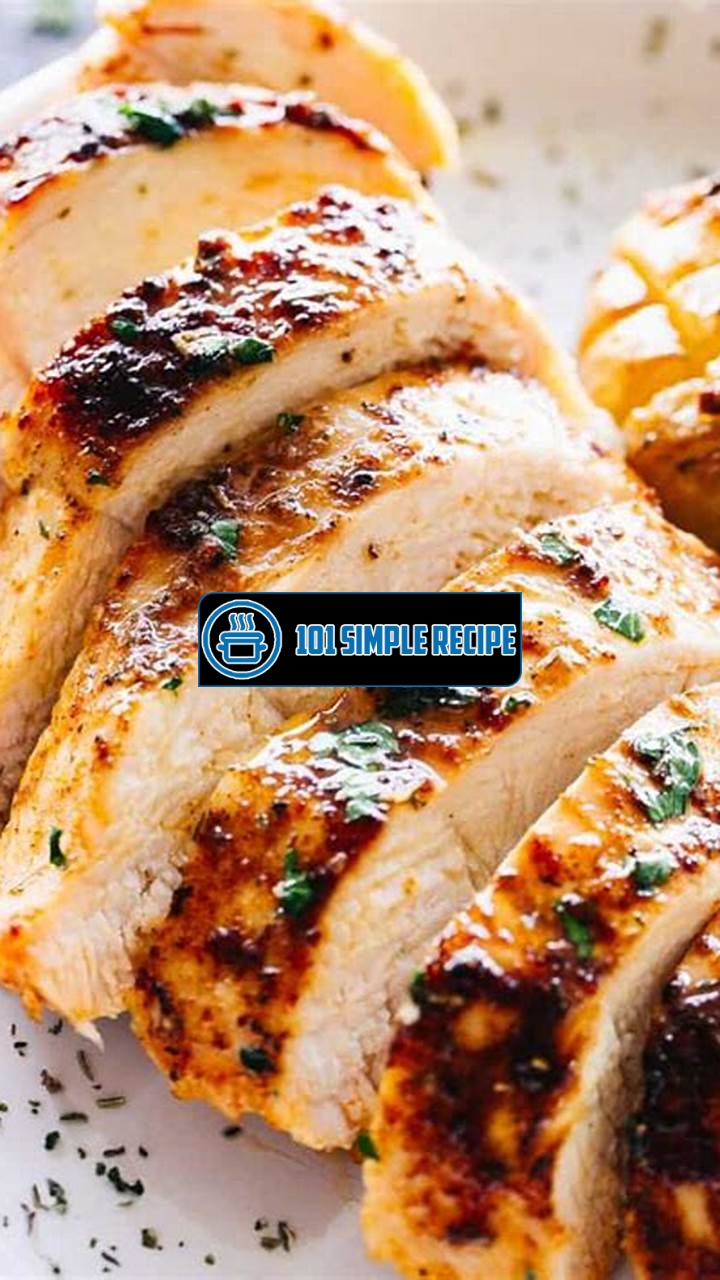Welcome to “The Expert’s Guide to Cooking Chicken Breast”! In this comprehensive guide, we will walk you through everything you need to know to create succulent and perfectly cooked chicken breast dishes at home. Whether you are a novice or a seasoned cook, cooking chicken breast can be intimidating. But fear not! With our step-by-step instructions, handy tips, and mouthwatering recipes, you will soon be on your way to becoming a chicken breast cooking expert. So, put on your apron, grab your cutting board, and let’s get started!

The Science of Cooking Chicken Breast
When it comes to cooking chicken breast, achieving tender and juicy results can sometimes feel like a daunting task. However, by understanding the science behind the process, you can master the art of cooking chicken breast to perfection, ensuring flavorful and succulent outcomes every time.
The Importance of Proper Seasoning
Seasoning plays a crucial role in enhancing the taste and tenderness of chicken breast. By properly seasoning your chicken, you can elevate its flavors and create a mouthwatering experience.
One key aspect of seasoning is the use of salt. Salt not only adds flavor but also helps in the retention of moisture. When salt is applied to the surface of the chicken, it helps draw out the protein-rich liquid and then gets reabsorbed, resulting in moist and juicy meat.
Additionally, you can experiment with various herbs and spices to elevate the taste profile of your chicken breast. Popular choices include garlic powder, paprika, thyme, and rosemary. These ingredients not only add flavor but also contribute to the overall appeal of your dish.
The Art of Brining Chicken Breast
Brining is a technique that involves soaking chicken breast in a saltwater solution, often combined with other flavorings, to enhance moisture retention and tenderness. This process is particularly beneficial when cooking lean cuts of meat like chicken breast.
When chicken breast is brined, the salt in the solution helps break down the protein structure, allowing it to retain more moisture during the cooking process. This results in a juicier and more flavorful end product. ️
To brine chicken breast, you can create a simple solution by dissolving salt and sugar in water, along with any desired spices or herbs. Let the chicken breast soak in the brine for a few hours or overnight in the refrigerator. Make sure to rinse the chicken thoroughly before cooking to remove excess salt.
Mastering the Cooking Methods
The cooking method you choose plays a critical role in determining the texture and flavor of your chicken breast. Here are a few popular cooking methods you can experiment with to achieve the desired results:
- Grilling: Grilling chicken breast imparts a smoky flavor and creates a slightly charred exterior. It is important to preheat the grill and brush the chicken lightly with oil to prevent sticking.
- Baking: Baking chicken breast in the oven is a convenient method that allows for even cooking. Use a meat thermometer to ensure the chicken reaches an internal temperature of 165°F (75°C) for safe consumption.
- Sautéing: Sautéing chicken breast in a hot pan with a small amount of oil allows for quick and flavorful cooking. Make sure to slice the chicken breast into thin cutlets for faster and more even cooking.
- Poaching: Poaching chicken breast involves gently simmering it in liquid, such as chicken broth or water, until cooked through. This method helps retain moisture and results in tender and juicy chicken.
By mastering these cooking methods and understanding their respective benefits, you can tailor your approach based on personal preferences and recipe requirements. Remember to always cook chicken breast to the appropriate internal temperature to ensure safety and optimal taste.
With these essential tips and a bit of practice, you can confidently cook chicken breast to perfection, delighting your taste buds and impressing your guests with succulent and flavorful results. Happy cooking! ️
Seasoning: Elevating the Flavor Profile
Uncover the secrets to enhancing the taste of chicken breast through the right selection and application of seasonings.
The Essential Seasonings for Chicken Breast
Seasonings play a crucial role in transforming an ordinary chicken breast into a mouthwatering masterpiece. To achieve the best flavor profile, it is important to have a well-rounded selection of essential seasonings.
1. Salt and Pepper: These two seasonings are the building blocks of flavor. They enhance the natural taste of chicken and create a solid foundation for other seasonings to shine. Use a generous amount of salt and freshly ground black pepper to season both sides of the chicken breast.
2. Garlic Powder: Garlic adds a rich and savory element to chicken breast. Sprinkle garlic powder on the chicken, ensuring it is evenly distributed for maximum flavor.
3. Paprika: This vibrant and slightly sweet spice adds color and a mild smoky flavor to the chicken. Choose sweet or smoked paprika based on your preference.
4. Thyme: The earthy and aromatic taste of thyme complements the natural flavors of chicken. Sprinkle dried thyme over the chicken to enhance its overall taste.
5. Onion Powder: Similar to garlic, onion powder adds depth and a touch of sweetness to chicken breast. It brings out the savory flavors and creates a well-rounded taste.
6. Italian Seasoning: This herb blend combines oregano, basil, thyme, and rosemary, adding complexity to the flavor profile. Be generous with the Italian seasoning to give your chicken a Mediterranean twist.
Marinating vs. Dry Rubs: Which is Better?
When it comes to seasoning chicken breast, two popular techniques stand out: marinating and dry rubs. Each method has its own advantages and it ultimately depends on your preferences.
Marinating: Marinating involves soaking the chicken breast in a flavorful liquid mixture for a period of time before cooking. It allows the flavors to penetrate the meat, resulting in a tender and juicy texture. Marinating also enhances the overall taste profile with a deeper infusion of flavors. You can use ingredients like citrus juice, soy sauce, olive oil, herbs, and spices to create a marinade.
Dry Rubs: Dry rubs consist of a mixture of herbs, spices, and seasonings that are directly applied to the surface of the chicken. They create a flavorful crust that adds texture and depth to the meat. Dry rubs are ideal for those who prefer a more intense and pronounced taste. You can customize your dry rub with various spices like cayenne pepper, chili powder, cumin, and brown sugar.
Techniques for Properly Seasoning Chicken Breast
Now that you have the essential seasonings and an understanding of marinating and dry rubs, let’s explore some techniques for properly seasoning chicken breast.
- Even Distribution: Ensure that the seasonings are evenly spread on both sides of the chicken breast. This guarantees a consistent flavor throughout the meat.
- Gently Massage: When applying seasonings, gently massage them into the chicken breast. This helps in enhancing the absorption of flavors into the meat.
- Time: Give enough time for the seasonings to work their magic. Whether marinating or using dry rubs, allow the chicken breast to sit for at least 30 minutes before cooking. This allows the flavors to penetrate the meat and results in a more flavorful dish.
- Experiment: Don’t be afraid to experiment with different seasonings and combinations. Try new flavors and spices to find your own signature seasoning for chicken breast.
By following these seasoning tips and techniques, you can elevate the flavor profile of your chicken breast and create a delicious and satisfying dish. So go ahead, get creative with your seasonings, and enjoy the best way to cook chicken breast!
The White Castle recipe is a popular choice when cooking chicken breast. It offers a unique and delicious flavor that is sure to satisfy your taste buds.
Brining: Achieving Moisture and Tenderness
Discover the secrets of brining and learn how this simple technique can elevate your chicken breast from dry and bland to moist and tender bites bursting with flavor. Brining involves soaking the meat in a solution of salt and water, allowing it to absorb moisture and seasoning. This process enhances the natural flavors of the chicken while keeping it juicy and tender during the cooking process.
The Science Behind Brining
Brining works through a process called osmosis, where the salt in the brine solution causes the chicken breast to retain more moisture. When the chicken is immersed in the brine, the salt draws water into the meat, resulting in a more juicy and flavorful end product. The brine also helps break down the proteins in the chicken, resulting in a tender texture.
Additionally, the salt in the brine enhances the overall seasoning of the chicken breast. As the meat absorbs the brine, it also absorbs the flavors of any additional seasonings or herbs that are added to the solution.
Brine Formulas for Perfectly Seasoned Chicken Breast
Creating a brine for chicken breast requires the right balance of salt, water, and additional flavors. There are countless variations of brine formulas, but a basic ratio to follow is 1 cup of salt to 1 gallon of water. This can be adjusted depending on personal preference and the size of the chicken breast being brined.
For additional flavor, consider adding herbs, spices, citrus zest, or even a sweetener like honey or maple syrup to the brine. These ingredients can infuse the chicken with delightful tastes that will complement various dishes.
Experiment with different brine formulas and flavor combinations to find your perfect blend. Remember to always taste the brine before soaking the chicken to ensure it has the desired flavor intensity.
Pro Tips for Brining Chicken Breast
To achieve the best results when brining chicken breast, consider the following expert tips:
- Brining Time: Brine the chicken breast for at least 30 minutes, but no more than 24 hours. Over-brining can lead to overly salty meat.
- Brining Container: Choose a non-reactive container, such as a food-grade plastic bag or a stainless steel or glass container, to hold the brine and chicken. Avoid using aluminum or other reactive metals.
- Refrigeration: Always brine chicken breast in the refrigerator to prevent bacterial growth. The meat should be fully submerged in the brine during the entire process.
- Rinsing: After brining, rinse the chicken breast thoroughly under cold water to remove excess salt from the surface. Pat it dry with paper towels before cooking.
- Cooking Method: When cooking brined chicken breast, adjust the cooking time and temperature as the brining process may shorten the cooking time. Use a meat thermometer to ensure the chicken reaches the desired internal temperature.
Remember, brining is a fantastic way to add moisture and flavor to your chicken breast. With the right brine formula and some expert tips, you can achieve perfectly seasoned, tender, and juicy chicken breast every time you cook.
So, why settle for dry and bland chicken breast when you can create a flavorful and succulent dish? Try brining your chicken breast using the tips and techniques discussed here, and prepare to impress your family and friends with your culinary skills.
Cooking Methods: From Pan-Searing to Sous Vide
In the world of cooking chicken breast, there are several methods that can be used to achieve the best results. Each method offers its own unique advantages and can cater to different preferences. Let’s explore these cooking methods and discover the deliciously cooked chicken breast they yield.
Pan-Seared Chicken Breast: Crispy on the Outside, Juicy on the Inside
Pan-searing is a popular cooking method that results in chicken breast with a crispy outer layer and a tender, juicy interior. It starts by heating a skillet over medium-high heat and adding a small amount of oil. Once the oil is hot, carefully place the chicken breast in the pan and let it cook for a few minutes on each side until it develops a golden-brown crust.
Important Point: The key to achieving a perfectly pan-seared chicken breast is to ensure that the skillet is hot enough before adding the chicken. This will help create the desired crispy texture on the outside while keeping the inside moist and flavorful.
Once the chicken is cooked through, remove it from the skillet and let it rest for a few minutes before slicing. This allows the juices to distribute evenly throughout the meat, resulting in a succulent and mouthwatering dish.
Oven-Baked Chicken Breast: Consistent and Foolproof
If you prefer a more hands-off approach to cooking chicken breast, then oven-baking is the method for you. This method offers consistent and foolproof results, making it a favorite among home cooks.
To oven-bake chicken breast, preheat your oven to the desired temperature (usually around 400°F) and place the chicken on a baking sheet. Season the chicken with your favorite herbs and spices, and drizzle it with a small amount of oil or melted butter for added flavor and moisture.
Note: You can also add a marinade or sauce to the chicken before baking for extra flavor. Just make sure to adjust the cooking time accordingly.
Place the baking sheet with the chicken in the preheated oven and let it cook for approximately 20-25 minutes, or until the internal temperature reaches 165°F. This ensures that the chicken is fully cooked and safe to consume.
Tip: For a crispy skin, you can turn on the broiler for the last couple of minutes of baking, but be sure to keep a close eye on it to prevent burning.
Sous Vide Chicken Breast: Precise Cooking for Tender Results
Sous vide is a cooking technique that involves sealing the chicken breast in a vacuum-sealed bag and cooking it at a precise temperature in a water bath. This method allows for precise control over the level of doneness and results in incredibly tender and juicy chicken breast.
The chicken breast is seasoned, sealed in a bag, and submerged in the water bath with the sous vide machine set to the desired temperature (usually around 145°F for a perfectly cooked chicken breast).
Important Point: The advantage of cooking chicken breast sous vide is that it eliminates the risk of overcooking, as the temperature can be maintained precisely. This ensures that the chicken remains moist and tender, without any dryness.
After the chicken has cooked for the recommended time (usually 1-2 hours), it can be finished off with a quick sear in a hot skillet or on a grill to achieve a beautiful caramelized crust.
Tip: Sous vide cooking requires a specialized machine, but it’s worth the investment if you’re looking for consistently perfect results.
In conclusion, these cooking methods provide a range of options to cook chicken breast to perfection. Whether you prefer a crispy and juicy pan-seared chicken breast, a consistent and foolproof oven-baked chicken breast, or a tender and precise sous vide chicken breast, there is a method to suit every preference. Experiment with each technique to find your favorite and enjoy the delicious results!
If you want to add some flavor to your chicken breast, consider trying this punch bowl recipe. It’s a tangy and refreshing dish that will leave you wanting more.
Unlocking the Secrets to Perfectly Cooked Chicken Breast
When it comes to cooking chicken breast, getting it just right can be a challenge. But fear not, because with a few expert tips and techniques, you can ensure that your chicken breast turns out perfectly cooked every time. Whether you’re grilling it, baking it, or pan-searing it, these secrets will help you achieve juicy and flavorful results.
Resting and Tenting: The Final Touch for Juiciness
Resting your chicken breast after cooking is a crucial step that many home cooks overlook. Allowing the meat to rest for a few minutes before slicing or serving allows the juices to redistribute, resulting in a juicier and more tender chicken breast. To further enhance the juiciness, you can tent the chicken breast with foil while it rests. This helps to retain heat and moisture, ensuring that your chicken breast stays juicy and delicious.
Expert tip: After cooking your chicken breast, let it rest for at least 5 minutes before slicing or serving. To keep it extra juicy, tent it with foil during the resting period.
Using a Meat Thermometer: Avoid Dry or Undercooked Chicken
Using a meat thermometer is the best way to ensure that your chicken breast is cooked to perfection. It takes the guesswork out of determining whether the chicken is undercooked or overcooked. The ideal internal temperature for a fully cooked chicken breast is 165°F (74°C). Insert the thermometer into the thickest part of the breast, avoiding the bone, and make sure it reaches the recommended temperature.
Expert tip: Invest in a good meat thermometer to accurately gauge the doneness of your chicken breast. This will help you avoid dry or undercooked chicken.
Delicious Chicken Breast Recipe Ideas to Try
Now that you know the secrets to perfectly cooked chicken breast, it’s time to put your newfound knowledge into practice with some delicious recipes. Here are a few ideas to get you started:
- Lemon Herb Grilled Chicken Breast: Marinate the chicken breast in a mixture of lemon juice, olive oil, garlic, and your favorite herbs. Grill until juicy and charred.
- Caprese Stuffed Chicken Breast: Cut a pocket into the chicken breast and stuff it with mozzarella cheese, cherry tomatoes, and fresh basil. Pan-sear until the cheese is melted and the chicken is cooked through.
- Asian-inspired Baked Chicken Breast: Coat the chicken breast in a mixture of soy sauce, honey, ginger, and garlic. Bake in the oven until golden brown and flavorful.
Expert tip: Experiment with different marinades, stuffings, and seasonings to create your own unique and delicious chicken breast recipes.
With these expert tips, you’ll be well on your way to cooking chicken breast like a pro. Remember to let it rest, use a meat thermometer, and try out some tasty recipes. Soon, you’ll be enjoying perfectly cooked chicken breast that is juicy, flavorful, and guaranteed to impress.
If you’re looking for a healthy option, try this weight loss recipe for chicken breast. It’s low in calories and packed with nutritious ingredients.
Frequently Asked Questions
Thank you for reading our article about the best way to cook chicken breast. We hope you found it informative and helpful. If you have any further questions or need more clarification, please take a look at the FAQs below.
| No. | Questions | Answers |
|---|---|---|
| 1. | What is the best way to cook chicken breast? | The best way to cook chicken breast is by baking it in the oven. This method ensures that the chicken remains juicy and tender while allowing the flavors to develop. Simply season the chicken breasts, place them on a baking sheet, and bake at 400°F (200°C) for about 20-25 minutes, or until the internal temperature reaches 165°F (74°C). |
| 2. | Can I grill chicken breast instead of baking it? | Yes, you can definitely grill chicken breast instead of baking it. Grilling adds a delicious smoky flavor to the chicken and gives it a nice charred exterior. Just make sure to preheat your grill to medium-high heat and cook the chicken for about 6-8 minutes per side, or until it reaches an internal temperature of 165°F (74°C). |
| 3. | Is it necessary to marinate chicken breast before cooking? | While marinating chicken breast is not necessary, it can greatly enhance the flavor and juiciness of the meat. Marinating allows the chicken to absorb the flavors of the marinade, resulting in a more flavorful and tender end product. If you have the time, we highly recommend marinating the chicken for at least 30 minutes to overnight before cooking. |
| 4. | Can I use a different seasoning for the chicken? | Absolutely! The seasoning options for chicken breast are endless. You can use a variety of herbs, spices, and marinades to add flavor to your chicken. Some popular choices include lemon pepper, garlic and herb, BBQ, and Cajun seasoning. Feel free to get creative and experiment with different combinations to find your favorite flavor profile. |
| 5. | What are some side dishes that pair well with chicken breast? | There are many delicious side dishes that pair well with chicken breast. Some popular options include roasted vegetables, mashed potatoes, steamed rice, salad, or a simple pasta dish. The key is to choose sides that complement the flavors of the chicken and create a well-rounded meal. |
| 6. | Can I freeze cooked chicken breast? | Yes, cooked chicken breast can be frozen for future use. Make sure to let it cool completely before placing it in an airtight container or freezer bag. Frozen cooked chicken can be stored for up to 3 months. To thaw, simply transfer it to the refrigerator overnight or use the defrost setting on your microwave. |
Thanks for reading and visit again!
We hope you enjoyed reading our article on the best way to cook chicken breast. Now that you have all the information and tips you need, it’s time to put them into practice and create delicious and flavorful chicken dishes. Whether you choose to bake, grill, or experiment with different seasonings, remember to always cook the chicken to the correct internal temperature of 165°F (74°C) to ensure it’s safe to eat. Don’t forget to visit our website for more tasty recipes and cooking tips. Happy cooking!
Jump to Recipe
Best Way to Cook Chicken Breast

Learn the best way to cook chicken breast to perfection with this easy-to-follow recipe.
- 4 chicken breasts
- 1 teaspoon salt
- 1/2 teaspoon black pepper
- 1 teaspoon garlic powder
- 1 teaspoon paprika
- Preheat the oven to 400°F (200°C). Season both sides of the chicken breasts with salt, black pepper, garlic powder, and paprika.
- Place the seasoned chicken breasts on a baking sheet lined with parchment paper. Bake in the preheated oven for 20-25 minutes, or until the internal temperature reaches 165°F (74°C).
- Remove the chicken from the oven and let it rest for a few minutes before serving. Serve with your favorite side dishes and enjoy!






